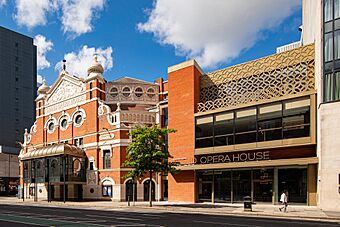Grand Opera House, Belfast facts for kids
|
Palace of Varieties (1904–1909)
|
|

Front facade
|
|
| Address | 2-4 Great Victoria St, Belfast BT2 7HR Northern Ireland |
|---|---|
| Coordinates | 54°35′42″N 5°56′06″W / 54.595°N 5.935°W |
| Owner | Grand Opera House Trust |
| Type | Visiting Production |
| Capacity | 1058 |
| Construction | |
| Opened | 23 December 1895 1980 (re-opening) |
| Closed | 1972 (first closure) 2006 (for extension) 2020 (for restoration) |
| Rebuilt | Restored 2020 |
| Years active | 1895–1972, 1980–present |
| Architect | Frank Matcham |
| Website | |
| www.goh.co.uk | |
The Grand Opera House is a famous theatre in Belfast, Northern Ireland. It was designed by Frank Matcham, a very well-known theatre architect. The theatre first opened its doors on December 23, 1895.
Many people think its main hall, called the auditorium, is amazing. It's known for its beautiful "oriental style" design. This style is quite unique for a theatre in the United Kingdom. The theatre's main hall was carefully restored in 2020 and 2021. The entrance areas and bars were also updated. This big project cost £12.2 million.
Today, the Grand Opera House hosts many different shows. You can see musicals, plays, ballet, opera, and comedy. They also have educational events and tours. Every year, the theatre puts on a special pantomime show. This tradition started in 1895 and is still very popular. The theatre can hold 1,058 people.
Contents
History of the Grand Opera House
The theatre first opened as the New Grand Opera House and Cirque. In 1904, its name changed to the Palace of Varieties. Then, in 1909, it became the Grand Opera House.
Early Performances and Famous Visitors
Many famous people performed here in the early days. Charlie Chaplin was on stage in 1908. Before World War II, the theatre mostly showed variety acts. But other stars also performed, like Nellie Melba and Gracie Fields.
During World War II, it became a theatre for plays. When the war ended, important leaders visited. These included Dwight D. Eisenhower and Bernard Law Montgomery, 1st Viscount Montgomery of Alamein. Lena Horne, a famous singer, also performed here in the 1940s.
After the war, more big stars came to the theatre. Laurel and Hardy, Vera Lynn, and Orson Welles all performed. Luciano Pavarotti, a world-famous opera singer, made his UK debut here. In 1965, the National Theatre brought a play with a star-studded cast. This included Laurence Olivier, Lyn Redgrave, and a young Anthony Hopkins.
Becoming a Cinema and Its Rescue
From 1961 to 1972, the Grand Opera House was used as a cinema. This happened after it was bought by the Rank Organisation.
In the early 1970s, business slowed down. The Rank Organisation planned to sell the theatre. The new owner wanted to tear it down and build offices. But some people worked hard to save it. Kenneth Jamison and Charles Brett helped the Arts Council of Northern Ireland buy the building.
In 1974, the theatre was officially protected as a listed building. The Department of Education helped fund a big renovation. The Grand Opera House reopened in 1980. After that, many more famous performers appeared. These included Liam Neeson, Rowan Atkinson, and Ian McKellen.
The theatre has been damaged by bombs a few times. This usually happened when the nearby Europa Hotel was attacked. It was badly damaged in 1991 and 1993. But the theatre always kept going. It continued to host musicals, plays, pantomimes, and live music.
Modern Updates and Restoration
In 1995, the Grand Opera House Trust took over running the theatre. In 2006, a new extension was added. This included a smaller studio theatre and more space for visitors. It also made the theatre more accessible for people with disabilities. The theatre reopened with a special event on October 21, 2006.
2020 Restoration Project
In 2020, the Grand Opera House closed again for a major restoration. Workers carefully cleaned and repaired the beautiful paintings and decorations in the main hall. New seats, carpets, and curtains were installed.
The design of the entrance and public areas was also updated. A new bar was added in a glass extension. The bars in the stalls and circle areas were also refurbished. The theatre's technical equipment was improved. A permanent exhibition was also created. This exhibition tells the story of the theatre's 125-year history.
See also
 In Spanish: Gran ópera de Belfast para niños
In Spanish: Gran ópera de Belfast para niños

